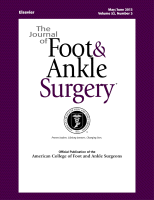
FOOT & ANKLE
No difference in postoperative clinical outcome of clamp vs manual reduction of unstable syndesmosis
J Foot Ankle Surg. 2018 Jan - Feb;57(1):19-2274 patients with a concurrent unstable syndesmotic injury with an external rotation-type ankle fracture were randomized to reduction of the syndesmosis using either a reduction clamp or through manual manipulation by the surgeon. Patients were assessed for radiographic outcome and clinical outcome over the first year after surgery. Result demonstrated that, although clamp reduction led to significantly reduced tibiofibular clear space and greater tibiofibular overlap compared to manual reduction, the rate of malreduction did not significantly differ between groups. Additionally, there were no significant differences in postoperative clinical outcome between groups, including pain, function, and ankle range of motion.
Unlock the full ACE Report
You have access to {0} free articles per month.Click below to unlock and view this {1}
Unlock NowCritical appraisals of the latest, high-impact randomized controlled trials and systematic reviews in orthopaedics
Access to OrthoEvidence podcast content, including collaborations with the Journal of Bone and Joint Surgery, interviews with internationally recognized surgeons, and roundtable discussions on orthopaedic news and topics
Subscription to The Pulse, a twice-weekly evidence-based newsletter designed to help you make better clinical decisions
Exclusive access to original content articles, including in-house systematic reviews, and articles on health research methods and hot orthopaedic topics
Or upgrade today and gain access to all OrthoEvidence content for just $1.99 per week.
Already have an account? Log in


Subscribe to "The Pulse"
Evidence-Based Orthopaedics direct to your inbox.
{0} of {1} free articles
Become an OrthoEvidence Premium Member. Expand your perspective with high-quality evidence.
Upgrade Now












































































